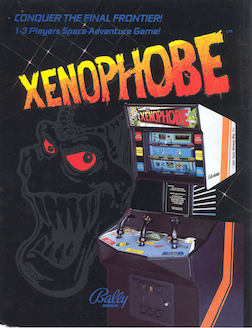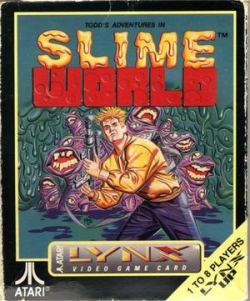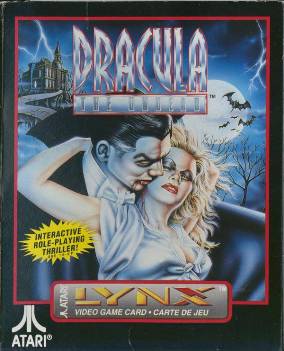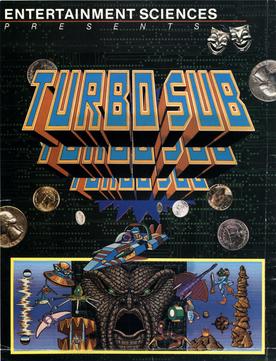
Xenophobe is a video game developed by Bally Midway and released in arcades in 1987. Starbases, moons, ships, and space cities are infested with aliens, and the players have to kill the aliens before each is completely overrun. The screen is split into three horizontally-scrolling windows, one for each of up to three players, yet all players are in the same game world.

Wonder Boy in Monster Land, known by its original arcade release as Wonder Boy: Monster Land, is a platform video game developed by Westone Bit Entertainment and released by Sega in Japanese arcades in 1987 and for the Master System in 1988, with a number of other home computer and console ports following. The game is the sequel to the 1986 game Wonder Boy and takes place eleven years after the events in the previous game. After enjoying over a decade of peace on Wonder Land following the defeat of the evil King by Tom-Tom, later bestowed the title "Wonder Boy", a fire-breathing dragon called the MEKA dragon appeared; he and his minions conquered Wonder Land, turning it into "Monster Land". The people, helpless due to their lack of fighting skill, call for Wonder Boy, now a teenager, to destroy the monsters and defeat the MEKA dragon. Players control Wonder Boy through twelve linear levels as he makes his way through Monster Land to find and defeat the MEKA dragon. Players earn gold by defeating enemies and buy weapons, armor, footwear, magic, and other items to help along the way.

Blockout is a puzzle video game published in 1989 by California Dreams. It was developed in Poland by Aleksander Ustaszewski and Mirosław Zabłocki. American Technos published an arcade version. Blockout is an unlicensed, 3D version of Tetris.

APB is a video game released in arcades by Atari Games in 1987. The player assumes the role of "Officer Bob," a rookie police officer. As Bob, players drive around the city, ticketing motorists for minor infractions and pulling over more serious offenders. Eventually, players must apprehend criminals for which an all-points bulletin has been called.

Pac-Land is a 1984 side-scrolling arcade platform game developed and released by Namco. It was distributed in North America by Bally Midway, and in Europe by Atari Games. Controlling Pac-Man, the player must make it to the end of each stage to return a lost fairy back to its home in Fairyland. Pac-Man will need to avoid obstacles, such as falling logs and water-spewing fire hydrants, alongside his enemies, the Ghost Gang. Eating large flashing Power Pellets will cause the ghosts to turn blue, allowing Pac-Man to eat them for points.

Paperboy is an arcade action game developed and published by Atari Games and Midway Games, and released in 1985. The player takes the role of a paperboy who delivers a fictional newspaper called The Daily Sun along a suburban street on his bicycle. The arcade version of the game featured bike handlebars as the controller.

Rampage is a 1986 arcade game by Bally Midway. Players take control of a trio of gigantic monsters trying to survive against onslaughts of military forces. Each round is completed when a particular city is completely reduced to rubble. Warner Bros. currently owns all rights to the property via their purchase of Midway Games. Inspired by monster films, Rampage spawned five sequels and a film adaptation in 2018.
Sinistar is a 1983 multidirectional shooter arcade game developed and manufactured by Williams Electronics. It was created by Sam Dicker, Jack Haeger, Noah Falstein, RJ Mical, Python Anghelo, and Richard Witt. Players control a space pilot who battles the eponymous Sinistar, a giant, anthropomorphic spacecraft. The game is known for its use of digitized speech and high difficulty level.

Rygar is a side-scrolling platform game created by Tecmo in 1986 and originally released for arcades in Japan as Argos no Senshi. The player assumes the role of a "Legendary Warrior", battling through a hostile landscape. The main feature of gameplay is the use of a weapon called the "Diskarmor", a shield with a long chain attached to it.

RoadBlasters is a combat racing video game released in arcades by Atari Games in 1987. In RoadBlasters, the player must navigate an armed sports car through 50 different rally races, getting to the finish line before running out of fuel.

Zarlor Mercenary is a vertically scrolling shooter for the Atari Lynx handheld console, developed by Epyx and published by Atari Corporation.

Todd's Adventures in Slime World is a side-scrolling platform video game first released for the Atari Lynx in 1990, with Sega Genesis and PC Engine Super CD-ROM² versions following in 1992.

Xybots is a 1987 third-person shooter arcade game by Atari Games. In Xybots, up to two players control "Major Rock Hardy" and "Captain Ace Gunn", who must travel through a 3D maze and fight against a series of robots known as the Xybots whose mission is to destroy all mankind. The game features a split screen display showing the gameplay on the bottom half of the screen and information on player status and the current level on the top half. Designed by Ed Logg, it was originally conceived as a sequel to his previous title, Gauntlet. The game was well received, with reviewers lauding the game's various features, particularly the cooperative multiplayer aspect. Despite this, it was met with limited financial success, which has been attributed to its unique control scheme that involves rotating the joystick to turn the player character.

Strider II, is a side-scrolling platform game published by U.S. Gold and originally released for various computer platforms in 1990. It is a European-developed sequel to Capcom's arcade video game Strider, which U.S. Gold previously ported to home computers in Europe.

Checkered Flag is a racing video game released for the Atari Lynx in 1991. A remake was released for the Atari Jaguar in 1994. Destination Software also planned to release a Game Boy Advance version of the title around 2005, but it was cancelled before it was released.

Dracula - The Undead is a video game released in 1991 for the Atari Lynx handheld system. The game is loosely based on Bram Stoker's novel Dracula and features Bram Stoker in the story as the narrator.

Turbo Sub is a first-person shoot 'em up released in arcades by Entertainment Sciences in 1985. Aliens have attacked the planet and the player fights them beneath the ocean using a submersible ship. Six years after the arcade original, Atari Corporation published a Lynx version, which adds a two-player mode.

NFL Football is an American football video game for the Atari Lynx. It was developed by Blue Sky Software, and published by Epyx in 1992.

World Class Fussball/Soccer is a football game for the Atari Lynx.

Ninja Gaiden is a 1990 adaptation of the 1988 arcade game for the Atari Lynx under license from Tecmo.





















